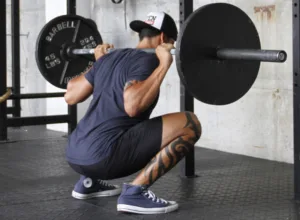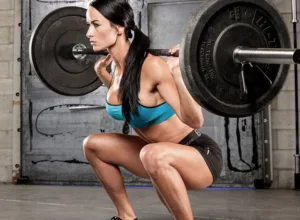The Squat is a king among exercises, building lower body strength, mobility, and core stability. But a common question plagues many: how deep should I squat? There’s no one-size-fits-all answer, and depth depends on several factors we’ll explore.
High bar vs. Low bar, front squat vs. back squat, wide stance vs. narrow, toes straight ahead vs. toes out – the list goes on for days and usually ends up turning into an argument that never ends and nobody wins.
On the topic of squat depth, we find ourselves amid similar contention.
There are coaches who say that if you’re not going all the way down to rock bottom, you’re wasting your time. Other coaches show a “good squat” as basically sticking your butt out as far as possible while letting your chest fall forward over your thighs.
Others still are stuck in powerlifting camp, where “making depth” is the name of the game – simply break parallel with the thigh and you’re golden.
The question is, who’s right?
The Obvious Answer: It Depends
I’m sure this wasn’t the answer you were looking to hear, but if there’s anything that is completely conditional in the world of strength training, it’s this:
Squatting depth is contingent upon many different factors.

 Finding Your Ideal Squat Depth:
Finding Your Ideal Squat Depth:
Here’s a more nuanced approach to squat depth:
-
Focus on Form: Before depth, prioritize proper form. Maintain a neutral spine with a slight arch in your lower back, core engaged, knees tracking over your toes, and heels flat on the ground.
-
Mobility Matters: If you lack ankle or hip mobility, reaching ATG depth might be difficult or risky. Focus on improving mobility through stretches and exercises before pushing depth.
-
Listen to Your Body: Pain is a red flag. If you experience pain during squats, especially in your knees or lower back, adjust your depth.
-
- Strength and Power: Parallel depth (thighs parallel to the ground) is a common recommendation for powerlifters and those focusing on strength development.
- Overall Fitness and Mobility: A comfortable depth that allows for good form and full range of motion is ideal.
Factors Affecting Squat Depth:
- Anatomy: Individual body structures differ. People with longer femurs or a more posterior pelvic tilt might find ATG squats challenging.
- Experience Level: Beginners might benefit from starting with shallower squats and progressively increasing depth with better control.
- Weight Used: Heavier weights may necessitate shallower squats to maintain proper form.
Here are the things that come into play.
Which Muscles Are You Targeting With Your Squat?
If you’re after quad development as the primary focus of your squat, chances are, you’ll want to squat deep. “That brings your knees to a greater degree of flexion, thus allowing your quads to contribute for a longer period of time (adding a load to the front as seen in front squats can definitely enhance this)”.
People who have issues with knee tracking and weak VMO’s would be smart to squat deeper to get at their quads a little harder.
If you’re looking for development or training of the posterior chain in more emphasis, then focusing on squats to parallel or midrange is usually a safe bet (adding a load to the back of the body as seen in barbell back squats will help this). Thinking about sticking the butt out and maintaining a vertical shin would be ideal, and squatting to a target can work doubly as a depth indicator and something to reach back for as you sit.
Check Out Our List Of The Best Supplements For Building Muscle, Shredding Muscle, Recovery, And Great Health, and Wellness Products! Purchase ifbnewsfeed.org‘s apparels Here: ifbnewsfeed.org
More on Maintaining Vertical Shins While Squatting
They’re a major player in determining squat depth. How? Because maintaining a vertical shin while squatting deep depends entirely on your leverages and proportions as a lifter. Consider this photo:

 The reason why the infant can stay upright while squatting to full depth isn’t just flexibility. It’s also the fact that his head and torso are 3 times the length and size of his legs. These proportions change drastically when a person grows up.
The reason why the infant can stay upright while squatting to full depth isn’t just flexibility. It’s also the fact that his head and torso are 3 times the length and size of his legs. These proportions change drastically when a person grows up.
In perspective, “the equivalent would be a lifter with a long torso and short legs as an adult. To be fair, these dimensions are common amongst Olympic lifters for the very reason that dropping into a deep front squat is a piece of cake for such proportions”.
For a person of different proportions (let’s use me as an example), it can frustrate the ability to squat deep when following a directive of keeping the knees from traveling forward over the toes. Reinforcing such a shortened pattern can end up haunting a lifter who doesn’t know when to break the “rules”.
Your Pelvic Construction Affects Squat ROM
Squatting to ATG depth may be completely off the table for a lifter whose pelvis and hips aren’t designed for it. Just like shoulders, the ball and socket joint of the hip can have a deeper nesting, a shallower nesting, and to add to that, they can be positioned closer towards the front of the body or further out towards the sides of the body.
All of these possibilities can cause the femurs to potentially be blocked by bone as far as squat depth goes. And in those cases, it’s better to avoid deep squatting, because the one thing that will be sure to happen to make depth is a compromise of skeletal safety and health.
Still… Work On Your Squat Mobility
Skeleton restrictions aside, I like telling my clients that it’s important to acquire the ability to squat deep, and then decide if you want to use that capability for the workout in question. It starts by working on the mobility of the squat pattern unloaded via specific drills.
The best drills to do this are ones that can open up the hip region, glutes, and quads while letting the groin stretch. Here are some of my favorites.
Spiderman Walk
Adding a twist and reach to the movement as seen here kills two birds with one stone by taking care of the health and rotation of the thoracic spine. This integrity of movement will only help keep a tall torso when squatting, which is essential for good quality.
Deep Squat Mobility
As mentioned above, this is a jack-of-all-trades when considering the requirements for a deep squat. Here, it’s fine to disregard low back positioning and the proper pelvic position; what’s most important is to keep the heels down as best you can and get to full knee flexion.
One reason a lot of squatters struggle to get deep is that they never give themselves a chance to try doing so with bad form. The only way to get better at a skill (in this case, deep squatting) is to practice that exact skill.
Again, adding a thoracic twist is a smart move to help stay more upright. It can also be very telling in what areas are restricting your freedom of mobility.
Tips for Optimal Squatting:
- Warm-up: Preparing your body with dynamic stretches and light cardio before squats is crucial.
- Gradual Progression: Increase weight or depth gradually as your strength and mobility improve.
- Variations: Consider incorporating different squat variations like box squats or front squats to target different muscle groups and work on mobility limitations.
- Seek Guidance: A qualified trainer can assess your form, mobility, and goals to recommend the optimal squat depth for you.
 Conclusion:
Conclusion:
There’s no magic squat depth. It’s a personal journey based on your body, goals, and experience. Prioritize proper form, listen to your body, and gradually progress. Remember, a well-executed squat at a comfortable depth is always better than a deeper squat with compromised form.
Wrapping Up
It’s not rocket science. Just all the other kinds of science.
First, develop the ability to squat deep, then use your training IQ to determine what depth of squat is best for you to focus on for your particular workout or program.
But don’t forget to practice squatting to all depths once you’ve got that covered.
More About Ideal Squat Depth Contents
- Here Is Everything You Need To Know About The King Of Strength Exercises: “The Back Squat”
- Learn On How To Improve Your “Squats Skills” And Perform It Properly
- The Best Way “To Front Squat” Without The Risk Of The Barbell Sliding
- The Side Affects Of Squatting: “The 5 Main Reasons” Why You Should Never Squat
- Quads Development: “Science Reveals Different Muscle Growth From Different Squat Depths”

- A1Supplements.com – America’s Favorite Supplement Store.
- Shop Optimum Nutrition Energy: Anytime & Pre-Workout
- A1Supplements.com – Lose Fat, Gain Muscle!







